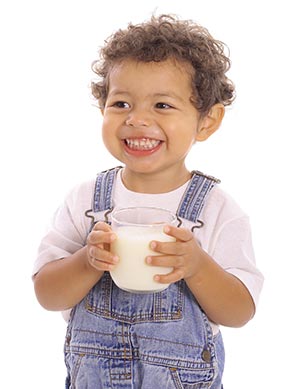Cow’s Milk and Milk Alternatives
Information about finding infant formula can be found here.external icon
Additional information to help families during the infant formula shortage can be found here.
Your growing child needs vitamins and minerals like vitamin D and calcium to build strong bones. Pasteurized, whole cow’s milk and soy beverages that have been fortifiedalert icon with vitamin D are good sources of vitamin D and calcium. Most cow’s milk sold in the United States is fortified with vitamin D.
Choose milk or milk alternatives that are unflavored and unsweetened. Flavored cow’s milk and fortified soy beverages can have added sugars. Your child does not need added sugars.
When Should I Introduce My Child to Cow’s Milk?
At 12 months old (but not before), your child can be introduced to cow’s milk. Before your child is 12 months old, cow’s milk may put him or her at risk for intestinal bleeding. It also has too many proteins and minerals for your baby’s kidneys to handle and does not have the right amount of nutrients your baby needs.
How Much, and How Often?
Cow’s milk or fortified soy beverages can be a part of a child’s balanced and diverse diet but not the only thing. The Dietary Guidelines for Americans recommend children aged 12 through 23 months get 1⅔ to 2 cup equivalents of dairy a day, including cow’s milk, yogurt, cheese, fortified soy beverages, and soy-based yogurt. If your child drinks too much cow’s milk, he or she may not be hungry for other foods with important nutrients. Some experts say that consuming too much cow’s milk can make it harder for your child’s body to absorb the iron he or she needs from foods.
Continue to follow your child’s cues to decide when he or she is hungry or full. Talk with your child’s doctor or nurse for more questions about adding cow’s milk or fortified soy beverages in his or her diet.
Whole Cow’s Milk or Lower Fat Cow’s Milk?
Children can drink unflavored, unsweetened whole cow’s milk. Whole cow’s milk is the same as lower fat cow’s milk except that it is higher in fat. It is important for young children to get fat in their diet for healthy growth and development. If your child has excessive weight gain or a family history of obesity, high cholesterol or triglycerides, or cardiovascular disease, talk to your child’s doctor or nurse about the type of cow’s milk to give.
Raw Milk
Raw milk and raw milk products from cows, goats, and sheep can carry harmful bacteria and other germs that can make your child very sick and can be life-threatening. Raw milk can also be called unpasteurized milk. Do not give your child raw or unpasteurized milk.
Milk Alternatives
Milk alternatives can include beverages made from plants, such as soy, oat, rice, coconut, cashew, and almond.
If you choose a milk alternative, here are things to remember:
- Milk alternatives should not be given before 12 months.
- Fortified soy beverages are the only milk alternative that help meet a child’s recommended dairy needs.
- Choose one that is unflavored and unsweetened. Your child does not need added sugars.
- Choose one that is fortified with vitamin D and calcium. Check labels, since nutrient content can vary between brands.
- Talk with your child’s doctor or nurse about the milk alternative you are using, because the vitamins and minerals in these types of milks are different than in cow’s milk.
Visit Vitamins & Minerals to learn more about the vitamins and minerals your child needs.

